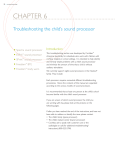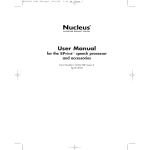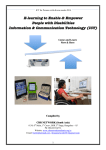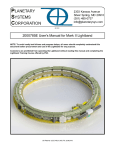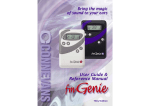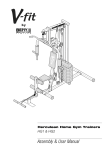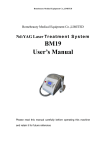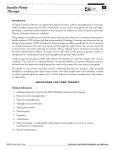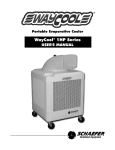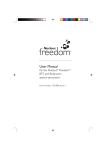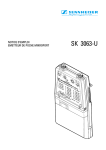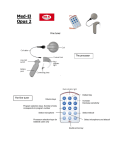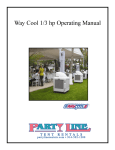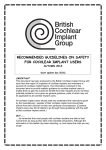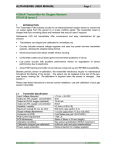Download ESPrit 3G sound processor and accessories
Transcript
User Manual for the ESPrit™ 3G speech processor and accessories Part Number: N94439F Issue 2 December 2001 N94439F ISS2 D01textMAS.p65 1 12/14/01, 4:52 PM N94439F ISS2 D01textMAS.p65 2 12/14/01, 4:52 PM Contents Introduction The Cochlear Implant System .............................................. 9 Hearing with Nucleus 24 ...................................................... 9 Nucleus 24 Cochlear Implant Models ............................. 10 ESPrit 3G Serial Number ................................................... 10 About This Manual ............................................................... 11 Part One: Using your ESPrit 3G ESPrit 3G Overview ............................................................................... 15 Battery Cover ....................................................................... 16 Under the Battery Cover................................................... 18 Transmitting Coil and Cable .............................................. 18 Coil Covers ................................................................................ 19 Magnet Strength ........................................................................ 20 Cable Lengths ............................................................................ 20 Attaching the Coil and Cable to your ESPrit 3G .............. 21 The Earhook ......................................................................... 22 Adjusting the Earhook ............................................................. 24 Batteries ................................................................................. 24 Replacing Batteries ................................................................... 26 Microphone ........................................................................... 28 Top Controls ......................................................................... 28 Program Selection Control .................................................... 29 Rotary Control ......................................................................... 29 Base Controls ....................................................................... 30 Mode Setting Switch ................................................................ 31 Accessories Adaptor Socket .................................................. 32 N94439F ISS2 D01textMAS.p65 3 12/14/01, 4:52 PM Part Two: Assistive Listening Assistive Listening Devices Overview ............................................................................... 35 Using the ESPrit 3G Built-in Telecoil Overview ............................................................................... 37 Telecoil and Microphone Mixing ....................................... 38 Use with a Telephone .......................................................... 39 Use with a Room Loop ...................................................... 40 Use with a Neck Loop (or Personal Induction Loop) . 41 Interference Noises ............................................................. 42 FM and IR Assistive Listening Devices Overview ............................................................................... 43 Transmission .......................................................................... 43 Reception............................................................................... 44 FM Systems............................................................................ 45 IR Systems ............................................................................. 47 Connecting Devices (Accessories) via the Accessories Adaptor Overview ............................................................................... 49 Accessories Adaptor ........................................................... 50 Lapel Microphone ................................................................ 54 External Telecoil ................................................................... 55 Sounds Heard by your Microphone, when Devices are Attached (i.e. Sound Mixing) ........................................ 56 FM Cable ................................................................................ 57 Accessory Adaptor Cable .................................................. 59 TV/Hi-Fi Cable ...................................................................... 60 Personal Audio Cable .......................................................... 62 Lapel Clip ............................................................................... 63 N94439F ISS2 D01textMAS.p65 4 12/14/01, 4:52 PM Part Three: Care and Troubleshooting Daily Use of your ESPrit 3G At the Start of Each Day .................................................... 67 At the End of Each Day ...................................................... 67 Overnight Storage ............................................................... 68 Care and Maintenance Cleaning ................................................................................. 71 External Parts ............................................................................ 71 Microphone ................................................................................ 71 Longer Term Storage ........................................................... 72 Other Do’s and Don’ts ...................................................... 72 Makeup and Hair Spray ........................................................... 72 Sand or Dirt ............................................................................... 73 Water .......................................................................................... 73 Troubleshooting Overview ............................................................................... 75 Testing your ESPrit 3G ........................................................ 78 Steps to Identify the Fault .................................................. 78 Switches and Controls ............................................................ 79 Batteries ...................................................................................... 79 Transmitting Coil and Cable .................................................. 80 Microphone ................................................................................ 80 Attached Accessory ................................................................. 81 Moisture...................................................................................... 81 Optional Monitoring Accessories ..................................... 82 Signal Check ............................................................................... 82 Monitor Earphones .................................................................. 83 N94439F ISS2 D01textMAS.p65 5 12/14/01, 4:52 PM Part Four: Further Information Programming Options Overview ............................................................................... 87 Program Selection................................................................ 87 Adjusting The Rotary Control .......................................... 88 Built-in Telecoil...................................................................... 89 Warnings and Precautions Warnings ................................................................................ 91 Medical Treatments Generating Induced Currents ........... 91 Loss of Residual Hearing ......................................................... 94 Long-term Effects of Electrical Stimulation ........................ 94 Small Parts Hazard ................................................................... 94 Battery Ingestion ...................................................................... 94 Head Trauma .............................................................................. 94 Precautions ............................................................................ 95 Theft and Metal Detection Systems ..................................... 96 Electrostatic Discharge ........................................................... 96 Mobile Telephones .................................................................... 97 General Information Technical Information .......................................................... 99 Specifications ............................................................................. 99 Operating Characteristics .................................................... 100 Registration ......................................................................... 102 International Labeling Symbols ....................................... 103 Appendix (for Clinicians) Magnets ................................................................................ 105 ESPrit 3G Programming Cable ........................................ 106 N94439F ISS2 D01textMAS.p65 6 12/14/01, 4:52 PM Table of Figures Figure 1: Serial Number ...................................................... 11 Figure 2: ESPrit 3G ............................................................... 16 Figure 3: Removing the Battery Cover ............................ 17 Figure 4: Under the Battery Cover .................................. 18 Figure 5: Transmitting Coil and Cable .............................. 18 Figure 6: Screws Holding the Cover ................................ 19 Figure 7: Magnet and Spacer Arrangement ..................... 19 Figure 8: Socket for the Transmitting Cable ................... 21 Figure 9: Connecting the Transmitting Cable ................. 21 Figure 10: Earhooks Available ............................................ 22 Figure 11: Removing the Earhook .................................... 23 Figure 12: Replacing the Earhook ..................................... 23 Figure 13: High Power Zinc Air Battery with Tab ......... 25 Figure 14: High Power Zinc Air Battery with Tab Removed........................................................................... 26 Figure 15: Removing the Batteries ................................... 27 Figure 16: Microphone Ports ............................................. 28 Figure 17: Top Controls ...................................................... 29 Figure 18: Base Controls .................................................... 30 Figure 19: Mode Settings .................................................... 31 Figure 20: Telecoil Sign ........................................................ 40 Figure 21: Accessories Adaptor ......................................... 51 Figure 22:Turning Off your ESPrit 3G ............................. 51 Figure 23: Adaptor Attached to your ESPrit 3G ............ 52 Figure 24: Re-setting your Top Controls ......................... 52 Figure 25: Wired Assistive Listening Devices ................. 53 Figure 26: Lapel Microphone ............................................. 54 Figure 27: External Telecoil................................................. 55 Figure 28: FM Cable ............................................................. 57 Figure 29: Accessory Adaptor Cable ................................ 59 Figure 30: TV/Hi-Fi Cable ................................................... 60 N94439F ISS2 D01textMAS.p65 7 12/14/01, 4:52 PM Figure 31: Volume Control on TV/Hi-Fi Cable ............... 61 Figure 32: Personal Audio Cable ....................................... 62 Figure 33: Cable in Clip ...................................................... 63 Figure 34: Cable Fitted with Rubber Band...................... 64 Figure 35: Signal Check ....................................................... 83 Figure 36: Program and Loudness Controls ................... 88 Figure 37: Magnet/Spacer Arrangements....................... 105 Tables Table 1: FM Cable Compatibility ....................................... 58 Table 2: International Labeling Symbols ......................... 103 N94439F ISS2 D01textMAS.p65 8 12/14/01, 4:52 PM Introduction The Cochlear Implant System The Nucleus® 24 cochlear implant system consists of three parts: • a speech processor, in this case an ESPrit™ 3G • a transmitting coil and cable • a Nucleus 24 cochlear implant Hearing with Nucleus® 24 To produce hearing sensations, using the Nucleus 24 cochlear implant system: • Sounds are received by the microphone positioned at the top of your ESPrit 3G or its built-in telecoil, or a mix of both. • Your ESPrit 3G codes those sounds. • Your transmitting coil transmits the coding to your cochlear implant. • The electrodes in your implant use this coded information to stimulate your cochlea’s hearing nerve fibers. • These hearing nerve fibers relay the sound signals to your brain, producing hearing sensations. ESPrit 3G User Manual ♦ 9 N94439F ISS2 D01textMAS.p65 9 12/14/01, 4:52 PM Introduction Your ESPrit 3G contains a specialized computer chip. The speech and environmental sounds are analyzed and digitized into coded signals by this chip. A custom modulation scheme transmits these signals to the electrodes on your implant’s array. Signals from the electrodes electrically stimulate your cochlea’s nerve fibers, generating sensations that your brain perceives as hearing. Nucleus 24 Cochlear Implant Models Nucleus 24 cochlear implant models available are: • Nucleus® 24 • Nucleus® 24k • Nucleus® 24 Contour™ • Nucleus® 24 Double Array* ESPrit™ 3G Serial Number The serial number is located under the battery cover, next to the batteries. For your future reference we suggest you write the number on your warranty card. It is important that your registration card be filled out by you or your clinician and returned to Cochlear. This assists if repairs are required, and enables Cochlear to meet regulatory requirements. * Not all implants are available (approved) for supply in all countries.Your clinician will know which implant you have. 10 ♦ ESPrit 3G User Manual N94439F ISS2 D01textMAS.p65 10 12/14/01, 4:52 PM Introduction Serial Number Figure 1: Serial Number About This Manual This manual contains information about the ESPrit 3G, a behind the ear speech processor (BTE), and the Nucleus 24 system. It is for recipients with a Nucleus 24 cochlear implant who use an ESPrit 3G. It may also be of interest to family and friends, teachers and caregivers of implant recipients. Part One describes how to use your ESPrit 3G and the transmitting coil and cable. Part Two provides information on using assistive listening devices to enhance your listening experience. Part Three deals with its care, and contains some troubleshooting suggestions. Part Four provides further information on your ESPrit 3G. ESPrit 3G User Manual ♦ 11 N94439F ISS2 D01textMAS.p65 11 12/14/01, 4:52 PM 12 ♦ ESPrit 3G User Manual N94439F ISS2 D01textMAS.p65 12 12/14/01, 4:52 PM Part One Using your ESPrit™ 3G ESPrit 3G User Manual ♦ 13 N94439F ISS2 D01textMAS.p65 13 12/14/01, 4:52 PM 14 ♦ ESPrit 3G User Manual N94439F ISS2 D01textMAS.p65 14 12/14/01, 4:52 PM ESPrit™ 3G Overview The ESPrit™ 3G is a small, lightweight, behind the ear speech processor for use with all Nucleus® 24 cochlear implants. The ESPrit 3G provides: • a sleek stylish design • a wide range of colors • a choice of coding strategies - ACE™ , SPEAK and CIS • a directional microphone • a built-in telecoil - to help you hear while using the phone - to enable wireless access to some assistive listening devices • a Whisper Setting for soft sounds • clearly visible and easy to use controls • the choice of two listening programs, customized for different listening situations • within each program, a choice between volume, sensitivity or autosensitivity/volume ESPrit 3G User Manual ♦ 15 N94439F ISS2 D01textMAS.p65 15 12/14/01, 4:52 PM ESPrit 3G Transmitting coil Top controls Microphone ports Earhook Transmitting cable Battery cover Base controls Figure 2: ESPrit 3G Battery Cover The lower part of your ESPrit 3G, the battery cover, is available in a variety of colors. You need to remove the battery cover to: • attach the transmitting coil and cable • change the earhook • change the batteries • change the battery cover to another color • view the serial number 16 ♦ ESPrit 3G User Manual N94439F ISS2 D01textMAS.p65 16 12/14/01, 4:52 PM ESPrit 3G To remove the battery cover: 1. Turn off the ESPrit 3G. 2. Hold the top section between the fingers of one hand. 3. Hold the lower part of the battery cover between the fingers of your other hand. 4. Slightly squeezing the battery cover, slide it downwards. Grip each side Grip each side and squeeze lightly Slide downwards Cover slides down and off Figure 3: Removing the Battery Cover To replace the battery cover: 1. Position the top of the cover at the ESPrit 3G base. 2. Slide the cover upwards, until it clips into place. ESPrit 3G User Manual ♦ 17 N94439F ISS2 D01textMAS.p65 17 12/14/01, 4:52 PM ESPrit 3G Under the Battery Cover Transmitting cable Earhook clips in 3 Zinc Air batteries Figure 4: Under the Battery Cover Transmitting Coil and Cable The transmitting coil and cable form one unit. They are available in four colors: beige, brown, black and grey. The coil sits on your head over your cochlear implant. It transmits the sound that has been coded by your ESPrit 3G across the skin to your implant’s receiver. The cable connects the transmitting coil to your ESPrit 3G. Transmitting coil Outer surface Removable cover Inner surface, that is held against your head Two screws Transmitting cable Figure 5: Transmitting Coil and Cable 18 ♦ ESPrit 3G User Manual N94439F ISS2 D01textMAS.p65 18 12/14/01, 4:53 PM ESPrit 3G Coil Covers Coil covers are also available in a variety of colors. To change your coil cover: 1. With the screwdriver provided, remove the screws at the back of the coil. Two screws Figure 6: Screws Holding the Cover 2. Take off the cover. Coil cover Large spacer Magnet, with marker facing down Transmitting coil Two screws, to hold cover firm over magnet and spacer Figure 7: Magnet and Spacer Arrangement ESPrit 3G User Manual ♦ 19 N94439F ISS2 D01textMAS.p65 19 12/14/01, 4:53 PM ESPrit 3G 3. Making sure the magnet(s) and spacer(s) arrangement has not changed, replace with the cover of your choice. 4. Replace the screws firmly. Magnet Strength Magnets hold the transmitting coil over the implant. The magnet strength determines how tightly the coil sits on your head. Your clinician will combine these to establish the magnetic strength that comfortably holds your coil in place. It is recommended you keep the hair around your coil area trimmed. Warnings: Consult your clinician if you wish to change your magnet arrangement. If the magnet strength is too weak the coil may fall off. If it is too strong, it may cause discomfort or skin irritation. Store screws, spare magnets and plastic spacers safely. Small parts may be hazardous if swallowed or may cause choking if inhaled. Cable Lengths There are a variety of cable lengths available. A short cable is used when you wear the ESPrit 3G on the side where your implant is located. A long cable can be used if you wear the ESPrit 3G on the other side of your head. Your clinician will assist you in choosing what is more appropriate for you. 20 ♦ ESPrit 3G User Manual N94439F ISS2 D01textMAS.p65 20 12/14/01, 4:53 PM ESPrit 3G Attaching the Coil and Cable to your ESPrit 3G To attach the transmitting cable to the ESPrit 3G: 1. Remove the battery cover. Socket for connecting transmitting cable Figure 8: Socket for the Transmitting Cable 2. Attach the cable’s yellow 4 pin connector to the yellow 4 pin socket (hole). Figure 9: Connecting the Transmitting Cable 3. Lay the cable along the channel next to the socket, with the cable extending from the side of the ESPrit 3G. 4. Replace the battery cover, sliding it until it clips into place. ESPrit 3G User Manual ♦ 21 N94439F ISS2 D01textMAS.p65 21 12/14/01, 4:53 PM ESPrit 3G The Earhook Two earhook options are available to hold your ESPrit 3G behind your ear: • The flexible titanium earhook alone, or with an optional soft earhook cover. • An earmold compatible earhook. An earmold is a custom formed device which helps hold hearing aids in place. Please see your cochlear implant center for more details. Titanium Earhook, with ball Earhook with soft cover Earhook for use with earmold Figure 10: Earhooks Available To remove the earhook: 1. Remove the battery cover. 2. Unclip the earhook. 22 ♦ ESPrit 3G User Manual N94439F ISS2 D01textMAS.p65 22 12/14/01, 4:53 PM ESPrit 3G Pull earhook away from your ESPrit 3G, to unhook Clips holding the earhook in place Battery cover removed Figure 11: Removing the Earhook To fit the flexible soft earhook cover: 1. Remove the earhook. 2. Starting at the narrow end of the earhook cover, feed the earhook through the channel of the earhook cover, until it sits against the ball of the earhook. To replace either earhook: 1. Feed the metal end back into the ESPrit 3G, clipping it into place. Push the earhook into the groove Slide it to the base of groove until it clicks into place Figure 12: Replacing the Earhook 2. Replace the battery cover. ESPrit 3G User Manual ♦ 23 N94439F ISS2 D01textMAS.p65 23 12/14/01, 4:53 PM ESPrit 3G Adjusting the Earhook Fit the ESPrit 3G earhook over your ear so that it is in the most comfortable position. The earhook can be gently bent to suit your ear. Note: Take care when bending the earhook. Do not distort the straight end of the earhook wire (the part that goes back into the ESPrit 3G). Batteries Your ESPrit 3G uses three high power 675 size hearingaid type batteries (button-type cells). High Power 675 Zinc Air batteries are recommended. However, in humid and cold conditions Silver Oxide S76 batteries may be more reliable. Discuss with your clinician which batteries may be more suitable for you. Warning: Batteries can be harmful if swallowed. Ensure that batteries are kept out of reach of young children. If swallowed, seek prompt medical attention at the nearest emergency center or call the National Button Battery Hotline collect on (202)625 3333. Note: The ESPrit 3G requires three good batteries to operate. It only takes one bad or substandard battery to stop the processor from working.When replacing dead batteries, always replace all three. 24 ♦ ESPrit 3G User Manual N94439F ISS2 D01textMAS.p65 24 12/14/01, 4:53 PM ESPrit 3G In optimal conditions High Power 675 Zinc Air batteries should power your ESPrit 3G for at least 14 hours with ACE™ and CIS at the maximum stimulus rate, and at least 50 hours with the SPEAK speech coding strategy. Expect a shorter battery life from silver oxide batteries as they have approximately one quarter of the capacity of a zinc air cell. Use only battery types recommended by your clinician, or Cochlear. Other types may not have sufficient power to allow your ESPrit 3G to function properly. Your power requirements will vary, depending on: • your program parameters • humidity and temperature • listening situations experienced • thickness of the skin covering your implant High Power 675 Zinc Air batteries are sealed, usually with a tab. Figure 13: High Power Zinc Air Battery with Tab The seal should be removed before use for at least one minute, to allow for air circulation. ESPrit 3G User Manual ♦ 25 N94439F ISS2 D01textMAS.p65 25 12/14/01, 4:53 PM ESPrit 3G Figure 14: High Power Zinc Air Battery with Tab Removed Silver Oxide S76 batteries do not have holes, are not sealed, and do not require air circulation. Follow the instructions and warnings for the brand you are using. Replacing Batteries Batteries should be replaced when the low battery warning ‘beeps’ are heard, or the sound you are hearing stops or your speech perception drops. Refer to the Troubleshooting section for further information. Immediately remove batteries that do not work. Over a period of time Zinc Air batteries may leak corrosive fluids. These can damage your ESPrit 3G. To change the batteries: 1. Before using Zinc Air batteries, remember to remove their seal and let them stand for one minute. 2. Turn off the speech processor. 3. Remove the battery cover: slide it down the ESPrit 3G. See Battery Cover section. 4. Remove the old batteries by tipping the ESPrit 3G to one side. They slide out from one side only. If the batteries are a little tight, and hence difficult to remove, apply a little pressure from the opposite side. Your battery cover can be used to push the battery 26 ♦ ESPrit 3G User Manual N94439F ISS2 D01textMAS.p65 26 12/14/01, 4:53 PM ESPrit 3G out. Alternately, use your transmitting coil’s magnet to draw the batteries out. Gently push battery out from the back Tip battery out Figure 15: Removing the Batteries 5. Using the cleaning brush, regularly clean the battery area and contacts, to prevent a build up of grime deposits. Never use abrasive materials or a blade. 6. Slide the new batteries into place. They only fit when: • Inserted from the side where the transmitting coil attaches, and • When the positive battery terminal (the side with the holes) faces up. 7. Replace the battery cover by sliding it up from the bottom until it clips into place. Note: Dispose of used batteries in accordance with your local regulations. Refer to Part Three: Care and Troubleshooting for further information. ESPrit 3G User Manual ♦ 27 N94439F ISS2 D01textMAS.p65 27 12/14/01, 4:53 PM ESPrit 3G Microphone The ESPrit 3G features a directional microphone, with a front and rear microphone port. Because it is a directional microphone, it is more sensitive to sounds originating from the front of your ESPrit 3G, and less sensitive to sounds originating from the side or rear. Rear microphone port Front microphone port Figure 16: Microphone Ports Position your head so the front microphone port points towards your desired sound source. This allows you to concentrate on that sound source and reduces the effect of other unwanted sound input. Refer to Part Three: Care and Troubleshooting for further information. Top Controls At the top of the ESPrit 3G there are two sets of controls: • The program selection control, for Off, P1 and P2. • A rotary control, which may be programmed to act as either a volume or sensitivity control. 28 ♦ ESPrit 3G User Manual N94439F ISS2 D01textMAS.p65 28 12/14/01, 4:53 PM ESPrit 3G Program selection control Volume or sensitivity control Figure 17:Top Controls Program Selection Control The ESPrit 3G offers you two different program settings, labeled P1 and P2. To change the programs, or to turn off the ESPrit 3G, move the program selection control switch, on the right, to the desired position. Note: Turn off your ESPrit 3G when you are not using it. It continues to use power unless turned off. When not using your ESPrit 3G for an extended period of time, remember to remove the batteries. Rotary Control The rotary control on the left controls the volume or level of loudness perceived. The source of the audio signal can be the built-in microphone, the built-in telecoil, an externally connected audio accessory or a combination of these. To adjust the level, turn the control until you find a comfortable listening level.Your clinician will tell you the approximate setting you should use for each program. The setting may differ for each program. ESPrit 3G User Manual ♦ 29 N94439F ISS2 D01textMAS.p65 29 12/14/01, 4:53 PM ESPrit 3G Note: If you adjust the sensitivity or volume setting often, or such adjustments cause you discomfort, the programs in your ESPrit 3G may need adjustment. Consult your clinician. Refer to the Troubleshooting section in Part Three. Base Controls On the base of the ESPrit 3G there is a: • switch for mode settings • socket for attaching accessories via an adaptor Note: A cover will be in the socket when you receive your ESPrit 3G. Remove the socket cover before inserting your Accessories Adaptor. Refer to Part Two for further information on the Accessories Adaptor and the devices or accessories available. Switch for mode settings Socket for attaching the Accessories Adaptor Figure 18: Base Controls 30 ♦ ESPrit 3G User Manual N94439F ISS2 D01textMAS.p65 30 12/14/01, 4:53 PM ESPrit 3G Mode Setting Switch The mode setting switch at the base of your ESPrit 3G provides options for receiving sound in different listening situations. It has three positions: • ‘M’ setting for microphone only • ‘W’ setting for Whisper Setting • ‘T’ setting for the built-in telecoil Slide the switch to use a particular mode. 'W' for Whisper Setting 'T' for telecoil 'M' for microphone Mode setting switch Figure 19: Mode Settings Microphone Setting The ‘M’ or microphone setting is the normal operating position, used where there are no specific or adverse listening conditions. Whisper Setting The ‘W’ or Whisper Setting makes soft sounds audible. ESPrit 3G User Manual ♦ 31 N94439F ISS2 D01textMAS.p65 31 12/14/01, 4:53 PM ESPrit 3G Built-in Telecoil Setting The ‘T’ setting activates your ESPrit 3G’s built-in telecoil. It can be programmed to operate as either a telecoil alone, or as a mix of telecoil and microphone. To use the built-in telecoil, move the mode setting switch at the base of the ESPrit 3G to the ‘T’ setting. Refer to the Assisted Listening section in Part Two, for further information on the built-in telecoil’s operation. Accessories Adaptor Socket Your Accessories Adaptor plugs into the socket at the base of your ESPrit 3G. When the adaptor is not being used, a socket cover should be inserted into the socket. Warning: Store spare socket covers safely. These small parts may be hazardous if swallowed or may cause choking if inhaled. 32 ♦ ESPrit 3G User Manual N94439F ISS2 D01textMAS.p65 32 12/14/01, 4:53 PM Part Two Assistive Listening Devices ESPrit 3G User Manual ♦ 33 N94439F ISS2 D01textMAS.p65 33 12/14/01, 4:53 PM 34 ♦ ESPrit 3G User Manual N94439F ISS2 D01textMAS.p65 34 12/14/01, 4:53 PM Assistive Listening Devices Overview Assistive listening devices can help to improve speech understanding in difficult hearing situations, such as in a house of worship, or auditorium. They reduce the effect of the distance between the sound source and the listener. The following factors may cause sound degradation and distortion: • poor room acoustics, e.g. echo/reverberation • background noise • distance between signal and listener Assistive listening devices may use wireless technology, or be wired. Wireless technology assistive listening devices you may want to try include: • induction loop systems • FM systems • Infrared light (IR) systems Your built-in telecoil operates with induction loop systems. Your built-in telecoil can also give you access to FM or IR systems, when a personal induction loop is connected to these systems. ESPrit 3G User Manual ♦ 35 N94439F ISS2 D01textMAS.p65 35 12/14/01, 4:53 PM Assisted Listening Wired assistive listening devices include: • Lapel microphone • TV/Hi-Fi cable • Personal Audio cable • External telecoil • FM cable These are attached to your ESPrit 3G by the Accessories Adaptor. 36 ♦ ESPrit 3G User Manual N94439F ISS2 D01textMAS.p65 36 12/14/01, 4:53 PM Using the ESPrit™ 3G Built-in Telecoil Overview The ‘T’ setting at the base of your ESPrit™ 3G activates your built-in telecoil, a small induction or pick-up coil. This telecoil allows you to receive signals from a hearing aid compatible telephone, a room fitted with an induction loop, or a personal induction loop, such as a neck loop. These latter are commercially available devices. The sound signal from an amplifier, TV or Hi-Fi can also be conveyed from an induction loop to the telecoil. The induction loop converts the electronic signal from the sound source (amplified sound system) to a magnetic signal. When activated, the built-in telecoil converts the magnetic signal to sounds for you to hear. The strength of the electrical current ‘induced’ in the telecoil varies according to the energy in the magnetic field from the telephone or wire loop, and the telecoil’s position in relation to that field. To find the strongest signal, you may need to experiment with: • The telephone position, for a phone conversation. • Where you sit in a room with an induction loop. ESPrit 3G User Manual ♦ 37 N94439F ISS2 D01textMAS.p65 37 12/14/01, 4:53 PM In-built Telecoil Note: If the induction loop strength is not sufficient then the reception will not be good. When used with a neck loop, the built-in telecoil may also be connected to FM or IR systems, or an external telecoil. Telecoil and Microphone Mixing The built-in telecoil can operate either: • mixed with microphone signals, or • on its own. Microphone/Telecoil Mix Setting When your ‘T’ setting has been programmed to receive a mixed microphone and telecoil signal, you can simultaneously detect both the acoustic signal received by the microphone, and the signal received by the built-in telecoil. For example, when using a telephone which has an induction loop you hear the person on the other end of the telephone and your own voice at the same time. Telecoil Only Setting You only hear the signals picked up by the telecoil (e.g. from the telephone or around a room) when your ‘T’ setting has been programmed for ‘telecoil only’. No sound is heard through the microphone: you do not hear your own voice, sounds of other people, or the immediate environment. 38 ♦ ESPrit 3G User Manual N94439F ISS2 D01textMAS.p65 38 12/14/01, 4:53 PM In-built Telecoil Your clinician will program the most appropriate setting based on your needs. Use with a Telephone Hearing aid compatible telephones have an induction loop, either built into the handset or separately fitted. To use a telephone fitted with an induction loop: 1. Hold the telephone near your ESPrit 3G. 2. Move the telephone receiver up and down along your ESPrit 3G to find the strongest signal. 3. Move your ESPrit 3G’s mode setting switch to the ‘T’ position. 4. Turn up the volume/sensitivity to the point where you experience sufficient loudness. 5. Begin your telephone conversation. 6. Adjust your volume as required. To find the place where the strongest signal is heard, move the telephone handset close to your ESPrit 3G, listening for the clearest and loudest signal. Different phones may require a slightly different placement. Where interfering magnetic fields are strong, effective telephone communication with a telecoil may not be possible. ESPrit 3G User Manual ♦ 39 N94439F ISS2 D01textMAS.p65 39 12/14/01, 4:53 PM In-built Telecoil Use with a Room Loop The built-in telecoil can receive a magnetic field from an induction loop running around a room, or under flooring. Public places often have signs indicating they have induction loops. These could include halls, auditoriums, train stations, places of worship and movie houses or cinemas. Figure 20: Telecoil Sign To listen using a room-fitted induction loop: 1. Make sure the speaker is using the microphone system supplying signals to your neck loop and receiver. 2. Make sure the loop system in the room is connected and switched on. 3. Move the mode setting switch on your ESPrit 3G to the ‘T’ position. 4. Move the volume/sensitivity control to the point where you experience sufficient loudness. 5. Further adjust your volume control as you require. The quality of the signal received from a room loop can vary.You may need to move to another location within the room to obtain the best sound. 40 ♦ ESPrit 3G User Manual N94439F ISS2 D01textMAS.p65 40 12/14/01, 4:53 PM In-built Telecoil Degraded performance may occur if the loop itself is faulty, or interference is present. Use with a Neck Loop (or Personal Induction Loop) Your built-in telecoil can also pick up the magnetic signals coming from an induction loop worn around the neck which is connected to a receiver. Your neck loop may be used directly with an induction loop system. Alternately, it may be attached to either FM or IR systems: the earphone socket of either the FM or IR receiver is plugged into the neck loop. Refer to FM and IR Assistive Listening Devices following for further information. It can be used with small and large area induction loop assistive listening systems. To listen, using a neck loop and the built-in telecoil: 1. Make sure the speaker is using the microphone system supplying signals to your neck loop and receiver. 2. Place the loop around your neck. 3. Move the mode switch of your ESPrit 3G to the ‘T’ position. 4. Move the volume control to a comfortable position. ESPrit 3G User Manual ♦ 41 N94439F ISS2 D01textMAS.p65 41 12/14/01, 4:53 PM In-built Telecoil Interference Noises When your ESPrit 3G is on the ‘T’ setting, strong magnetic fields from appliances, power lines and transformers, fluorescent lights, computers and other electronic equipment may interfere with your sound quality. These may create unwanted buzzing, whistling, crackling or hissing sounds. To try to minimize such interference switch off any unnecessary equipment or appliances. Move away from the noise source, to where the interfering electromagnetic field is weakest. Alternately, a separately available external telecoil may help when this local environmental noise stops the builtin telecoil from clearly processing sounds, e.g. when a computer monitor interferes with your reception. 42 ♦ ESPrit 3G User Manual N94439F ISS2 D01textMAS.p65 42 12/14/01, 4:53 PM FM and IR Assistive Listening Devices Overview FM and IR (Infrared light) systems are additional wireless technologies used to assist in hearing. Refer to the instructions that accompany any assistive listening devices that you use. Transmission With FM or IR assistive listening devices, sound is received at the ‘input’ of the transmitter. This ‘input’ may be either: • a microphone placed close to the desired sound source (the closer the better), or • a direct audio feed e.g. a cable from a TV, VCR or stereo. The transmitter then sends the signal to a receiver (and amplifier), producing an amplified signal. It may be either an FM or IR receiver. ESPrit 3G User Manual ♦ 43 N94439F ISS2 D01textMAS.p65 43 12/14/01, 4:53 PM FM and IR Devices Reception There are two ways for your ESPrit™ 3G to receive the amplified signal from FM and IR assistive listening devices: • Using the built-in telecoil (wireless) The receiver and amplifier is attached to an induction loop such as a room loop or neck loop. To operate using your ESPrit 3G, select the ‘T’ position on the mode switch. For some environments it may be helpful to have your ‘T’ setting programmed for a microphone/telecoil mix. This allows you to hear both your own voice and others talking, while using your telecoil. Discuss this with your clinician. This option can be set when your clinician programs your ESPrit 3G. • Using cables connected to the Accessories Adaptor (wired) The receiver and amplifier is attached to your ESPrit 3G through cables via your Accessories Adaptor (plugged into the base of the ESPrit 3G). For FM systems, attach the FM receiver via the appropriate ESPrit 3G FM cable. For IR systems, attach the IR receiver cable to the Personal Audio cable. This is then plugged into the Accessory Adaptor cable, which in turn plugs into the Accessories Adaptor. 44 ♦ ESPrit 3G User Manual N94439F ISS2 D01textMAS.p65 44 12/14/01, 4:53 PM FM and IR Devices Refer to the section Connecting Devices (Accessories) via the Accessories Adaptor for further information. FM Systems FM systems use FM radio waves to transmit the signal from transmitter to receiver. The transmitter input signal can be from either a microphone or other electronic sound signal. Each FM system usually consists of a single transmitter to broadcast to one or more receivers tuned to the same channel. Since each system can use its own broadcast frequency, several systems may operate simultaneously at one location without interfering with one another. When using an FM receiver, the person speaking should be wearing a transmitter compatible both with your receiver, and with its operating frequency. The FM receiver output may be sent to the ESPrit 3G via either: • a compatible neck loop (personal induction loop), or • the Accessories Adaptor and the FM cable appropriate for that FM receiver. Reception Problems and Interference Signals received from an FM transmitter must compete with other electrical signals. These competing electrical signals may include electrical interference. ESPrit 3G User Manual ♦ 45 N94439F ISS2 D01textMAS.p65 45 12/14/01, 4:53 PM FM and IR Devices Interference generally increases with the distance between the FM transmitter and receiver, or with proximity to the source of interference. Interfering signals can arise from: • a TV or PC monitor • nearby transmitting towers • electric motors • domestic appliances and electronic equipment • fluorescent lighting When there is a significant distance between the FM transmitter and receiver such as occurs in an auditorium or large classroom, you may notice some interference from your ESPrit 3G. To minimize any interference: • Ensure there is a clear signal path between the FM transmitter and your FM receiver. • Move closer to the FM transmitter. • Spend a few minutes experimenting with the position or orientation of the FM cable and FM receiver. • Move your FM receiver and its cables away from the interference source, including your ESPrit 3G. 46 ♦ ESPrit 3G User Manual N94439F ISS2 D01textMAS.p65 46 12/14/01, 4:53 PM FM and IR Devices IR Systems IR (infrared) systems use invisible infrared light to carry the sound from the source to a receiver. The signal from either a microphone or audio feed passes through a transmitter, which comprises a number of infrared emitters. The signal travels to one or more receivers, all set or tuned to the same channel. IR systems are similar to FM systems, with the following exceptions: • Receivers should generally be in ‘line of sight’ (depending on the emitter power and reflective surfaces) of the emitter. (This is similar to many TV remote controls.) • The signal can only be received inside a covered room, away from strong light. The IR receiver may be used with the ESPrit 3G via either: • a compatible neck loop (or personal induction loop), or • the Accessories Adaptor and a cable appropriate for the IR receiver. ESPrit 3G User Manual ♦ 47 N94439F ISS2 D01textMAS.p65 47 12/14/01, 4:53 PM 48 ♦ ESPrit 3G User Manual N94439F ISS2 D01textMAS.p65 48 12/14/01, 4:53 PM Connecting Devices (Accessories) via the Accessories Adaptor Overview The following assistive listening devices can be connected to your ESPrit™ 3G using the Accessories Adaptor: • lapel microphone • external telecoil • FM cable • TV/Hi-Fi cable • Personal Audio cable An Accessory Adaptor cable is required to connect both the TV/Hi-Fi and Personal Audio cables to the Accessories Adaptor. A lapel clip, to hold either the Accessory Adaptor cable or the lapel microphone cable in position, is also available. Refer to the sections following for further information. The above devices (accessories) may not be available in all regions. Please contact your cochlear implant center if you have questions about their availability. ESPrit 3G User Manual ♦ 49 N94439F ISS2 D01textMAS.p65 49 12/14/01, 4:53 PM Connecting Devices via Accessories Adaptor Note: Switch off your ESPrit 3G before connecting or removing an accessory, and switch it on again once the device is in place. This allows your ESPrit 3G to recognize the new system. Accessories Adaptor The Accessories Adaptor plugs into the socket at the base of the ESPrit 3G. It allows the following to be attached to the ESPrit 3G: • Accessory Adaptor cable • lapel microphone • FM cable • external telecoil The TV/Hi-Fi cable and Personal Audio cable attach to the Accessory Adaptor cable. Monitor earphones, for use by your clinician, family and friends to check if the microphone is working correctly, can be attached using the 3 pin socket on the side of the adaptor. Switch your ESPrit 3G ‘Off’ before you attach or remove the accessory, and then ‘On’ again after the accessory has been attached or removed. This will reset the connection within your ESPrit 3G. 50 ♦ ESPrit 3G User Manual N94439F ISS2 D01textMAS.p65 50 12/14/01, 4:53 PM Connecting Devices via Accessories Adaptor Plug for your ESPrit 3G Socket for your monitoring earphones Socket for your accessories or wired assistive listening devices Figure 21: Accessories Adaptor Using an Accessory To use an accessory: 1. Turn off the ESPrit 3G (top controls) and remove it from your head. Turn Off 'O' for Off Figure 22: Turning Off your ESPrit 3G 2. Remove the socket cover from your Accessories Adaptor socket, at the base of your ESPrit 3G. Warning: Parents and caregivers should be counseled that the external implant system contains small parts that may be hazardous if swallowed or may cause choking if inhaled. 3. Push the adaptor firmly into the socket at the base of the ESPrit 3G, until it snaps into place. ESPrit 3G User Manual ♦ 51 N94439F ISS2 D01textMAS.p65 51 12/14/01, 4:53 PM Connecting Devices via Accessories Adaptor Push adaptor into the socket Figure 23: Adaptor Attached to your ESPrit 3G 4. Attach the accessories and/or monitor earphones. 5. Place your ESPrit 3G back on your head and switch it to P1 or P2 (top controls). 6. Set the sensitivity or volume control initially to 4.Your clinician will tell you the approximate range of sensitivity or volume you should use. Turn Off 'O' for Off Figure 24: Re-setting your Top Controls 7. Increase or decrease the sensitivity or volume control to the desired level. If your ESPrit 3G does not work, switch it ‘Off’ and ‘On’ again. This will reset your ESPrit 3G. 52 ♦ ESPrit 3G User Manual N94439F ISS2 D01textMAS.p65 52 12/14/01, 4:53 PM Connecting Devices via Accessories Adaptor ESPrit 3G with Accessories Adaptor attached External Telecoil Lapel Microphone FM Cable Accessory Adaptor Cable TV/Hi-Fi Cable Personal Audio Cable ESPrit 3G microphone enabled: mixing is available ESPrit 3G microphone disabled Figure 25: Wired Assistive Listening Devices ESPrit 3G User Manual ♦ 53 N94439F ISS2 D01textMAS.p65 53 12/14/01, 4:53 PM Connecting Devices via Accessories Adaptor Lapel Microphone The lapel microphone can improve communication in noisy environments. Figure 26: Lapel Microphone It plugs into the Accessories Adaptor that attaches to the base of the ESPrit 3G. The microphone of your ESPrit 3G is disabled when connected to the lapel microphone. Point the microphone toward the speaker’s mouth. In general place the microphone no more than 40 inches (1 meter) from the speaker. The surrounding noise level will influence how closely you need to place or hold the microphone to the speaker. Some suggestions for placing your lapel microphone to get the best input signal are: • When speaking with one person, try clipping the microphone to their clothing, or ask them to hold it. • When talking in a small group, either pass the microphone from speaker to speaker or place it on the table, in front of the group. • In a car, clip the microphone to the clothing of the other person, or where you wish to hear a number of people, attach it to the overhead light. • In a group setting, some people clip their lapel microphone to a glass, a sugar bowl or something similar. 54 ♦ ESPrit 3G User Manual N94439F ISS2 D01textMAS.p65 54 12/14/01, 4:53 PM Connecting Devices via Accessories Adaptor External Telecoil While the built-in telecoil will meet most needs, an external telecoil device can be used when the local environmental noise does not allow the built-in telecoil to process sounds clearly, e.g. a computer monitor prevents clear reception. The external telecoil allows you to remain a small distance from a source of local interference. The external telecoil may be used with your Accessories Adaptor, or with a neck loop. The microphone of your ESPrit 3G is disabled when the external telecoil is connected. Figure 27: External Telecoil ESPrit 3G User Manual ♦ 55 N94439F ISS2 D01textMAS.p65 55 12/14/01, 4:53 PM Connecting Devices via Accessories Adaptor Sounds Heard by your Microphone, when Devices are Attached (i.e. Sound Mixing) Unless programmed otherwise, sound can be heard simultaneously from both your ESPrit 3G microphone and the device, when using the • FM cable • TV/Hi-Fi cable • Personal Audio cable Sounds from either the FM system, TV, stereo, personal computer or battery powered equipment are heard simultaneously with environmental sounds picked up by your ESPrit 3G microphone. This is called audio mixing. To obtain a good balance between the two sound sources, use the volume or sensitivity control, i.e. the left hand control at the top of your ESPrit 3G. (The choice between using volume or sensitivity is made when your programs, P1 and P2 are determined.) The control level should be set at 2 or more to operate the microphone effectively when using these accessories. To hear more environmental sounds, turn up the control. To hear less environmental sound, turn down your control. Where applicable, the volume control of the attached device can also be adjusted. 56 ♦ ESPrit 3G User Manual N94439F ISS2 D01textMAS.p65 56 12/14/01, 4:53 PM Connecting Devices via Accessories Adaptor FM Cable The FM cable transfers audio signals from a commercially available FM listening system to your ESPrit 3G. Figure 28: FM Cable The end marked ‘Cochlear’ plugs into the Accessories Adaptor (that attaches to the base of the ESPrit 3G). The other end plugs into the FM receiver. The following FM cables are available from Cochlear to connect to the various FM systems. ESPrit 3G User Manual ♦ 57 N94439F ISS2 D01textMAS.p65 57 12/14/01, 4:53 PM Connecting Devices via Accessories Adaptor FM System Transmitter Receiver FM Cable Connevans CRMT 200 CRMR 200 FM12-E Panasonic WX-1600 RD-544/11 FM18-E Phonak Microvox MTxxxxx MRxxxxx* (with com1 output module) FM14-E Phonic Ear PE 300T Easy Listener PE 300 R FM 2-E Phonic Ear PE 300T Easy Listener PE 350 R FM 2-E Phonic Ear PE 471 T PE 475 R FM 13-E Phonic Ear PE 481 FST PE 475 R FM 10-E Phonic Ear Solaris PE 571 T PE 575 R FM 19-E Sennheiser Mikroport SK 2013 PLL EK 2013 PLL FM 15-E * For the Phonak Microvox, only transmitters and receivers with five digit serial numbers, MT xxxxx and MR xxxxx, are compatible. Any system with six digit serial numbers, M xxxxxx, will not provide satisfactory transmitting range. Table 1: FM Cable Compatibility 58 ♦ ESPrit 3G User Manual N94439F ISS2 D01textMAS.p65 58 12/14/01, 4:53 PM Connecting Devices via Accessories Adaptor Accessory Adaptor Cable The Accessory Adaptor cable is a mono-audio adaptor cable that plugs into the Accessories Adaptor which plugs into the base of your ESPrit 3G. Either the TV/Hi-Fi cable or the Personal Audio cable can plug into the Accessory Adaptor cable. Attach to Accessories Adaptor Attach to Accessory Figure 29: Accessory Adaptor Cable To attach the Accessory Adaptor cable to the ESPrit 3G: 1. Plug the Accessory Adaptor cable into either the TV/Hi-Fi cable, or the Personal Audio cable, whichever accessory you want to use. 2. Plug the connector end of the Accessory Adaptor cable (marked ‘Cochlear’) into the bottom socket of the Accessories Adaptor. 3. Turn off your ESPrit 3G. 4. Plug the Accessories Adaptor into its base. 5. Turn on your ESPrit 3G. ESPrit 3G User Manual ♦ 59 N94439F ISS2 D01textMAS.p65 59 12/14/01, 4:53 PM Connecting Devices via Accessories Adaptor TV/Hi-Fi Cable The TV/Hi-Fi cable is used to connect a TV, stereo or personal computer to your ESPrit 3G. Volume Control Isolation Box Figure 30:TV/Hi-Fi Cable It can be used with devices that either plug into wall outlets or are battery operated. Always use the TV/Hi Fi cable when the TV, stereo or personal computer is connected to a wall outlet. The cable’s electrical isolation is designed to prevent electric shock from occurring. Caution: Do not use this cable during electrical storms. As a precaution, always remove any accessory cable from your ESPrit 3G during an electrical storm. Connecting the TV/Hi-Fi cable The TV/Hi-Fi cable must be plugged into the Accessory Adaptor cable which is then plugged into the Accessories Adaptor, attached to the base of the ESPrit 3G. To use your TV/Hi-Fi cable: 1. Plug the cable connector marked ‘TV1’ into the earphone or headphone output socket of your TV, stereo or personal computer. 60 ♦ ESPrit 3G User Manual N94439F ISS2 D01textMAS.p65 60 12/14/01, 4:53 PM Connecting Devices via Accessories Adaptor 2. Plug the cable connector marked ‘Cochlear’ into the Accessory Adaptor cable. 3. Turn off your ESPrit 3G. 4. Plug the Accessory Adaptor cable into the Accessories Adaptor. 5. Plug the Accessories Adaptor into the base of your ESPrit 3G. 6. Turn on the ESPrit 3G and select the appropriate program, P1 or P2. 7. Adjust the volume or sensitivity level on your ESPrit 3G to balance the environmental noises with the sound source. 8. Adjust the volume of your audio equipment using the control knob on the TV/Hi-Fi cable. Figure 31:Volume Control on TV/Hi-Fi Cable Your clinician will advise you on the program settings to use with your TV, stereo or personal computer: • On position 1 the volume is very low and few sounds are picked up from the TV, stereo or personal computer. • On position 5 the maximum volume is picked up from the TV, stereo or personal computer. ESPrit 3G User Manual ♦ 61 N94439F ISS2 D01textMAS.p65 61 12/14/01, 4:53 PM Connecting Devices via Accessories Adaptor Personal Audio Cable The Personal Audio cable can be used to connect batterypowered equipment to your ESPrit 3G, e.g. a personal stereo. Figure 32: Personal Audio Cable An Accessory Adaptor cable must be used to connect the Personal Audio cable to the ESPrit 3G. To connect your Personal Audio cable: 1. Plug the connector marked ‘WALK1’ on the Personal Audio cable into the output socket of your battery powered equipment. 2. Plug the connector marked ‘Cochlear’ on the Personal Audio cable into the Accessory Adaptor cable. 3. Plug the Accessory Adaptor cable into the base of the Accessories Adaptor. 4. Turn off the ESPrit 3G. 5. Plug the Accessory Adaptor cable into the ESPrit 3G. 6. Turn on your ESPrit 3G and select the appropriate program P1 or P2. 7. Adjust the volume or sensitivity level on your ESPrit 3G to balance the environmental noices with the sound source. Since the Personal Audio cable does not have a volume control, to find a comfortable level you may need to 62 ♦ ESPrit 3G User Manual N94439F ISS2 D01textMAS.p65 62 12/14/01, 4:53 PM Connecting Devices via Accessories Adaptor adjust the volume control on the battery powered equipment. Caution: DO NOT USE the Personal Audio cable to connect to equipment using a wall outlet. Lapel Clip The lapel clip can be used to hold either the Accessory Adaptor cable or the lapel microphone cable in position. To hold the cable securely in one postion: 1. Place one prong of the lapel clip through the rubber band. 2. Pass the cable through the rubber band as shown. Figure 33: Cable in Clip 3. Loop the rubber band twice around the inner slot of the lapel clip. 4. Gently pull the cable through the jaws of the clip to fit in the same slot as the rubber band. ESPrit 3G User Manual ♦ 63 N94439F ISS2 D01textMAS.p65 63 12/14/01, 4:53 PM Connecting Devices via Accessory Adapter Figure 34: Cable Fitted with Rubber Band 5. Attach the clip to your clothing. You can move the cable through the clip by opening the jaws and gently pulling the cable through its slot.You can then attach the clip to a convenient place on your clothing. 64 ♦ ESPrit 3G User Manual N94439F ISS2 D01textMAS.p65 64 12/14/01, 4:53 PM Part Three Care and Troubleshooting ESPrit 3G User Manual ♦ 65 N94439F ISS2 D01textMAS.p65 65 12/14/01, 4:53 PM 66 ♦ ESPrit 3G User Manual N94439F ISS2 D01textMAS.p65 66 12/14/01, 4:53 PM Daily Use of your ESPrit™ 3G At the Start of Each Day 1. Remove your ESPrit™ 3G from your ESPrit 3G case. 2. Close your ESPrit 3G case. 3. Place your ESPrit 3G and transmitting coil on your head. 4. Turn on your ESPrit 3G. At the End of Each Day 1. Turn off your ESPrit 3G. 2. Remove your ESPrit 3G from your head. 3. Place your ESPrit 3G in your ESPrit 3G case with an activated drying capsule to dry out any moisture. This is particularly important for those in humid climates, or after physical or sporting activities. Refer to Overnight Storage section following for further information. ESPrit 3G User Manual ♦ 67 N94439F ISS2 D01textMAS.p65 67 12/14/01, 4:53 PM Daily Use Caution: The stimulation levels of your ESPrit 3G are programmed to your individual needs. Never swap your ESPrit 3G with another person. It is important to ensure children do not use someone else’s speech processor. Use of a speech processor that has not been programmed to your specific needs could result in stimulation above your comfort level (C-level). Overnight Storage Your ESPrit 3G case, with an activated drying capsule, acts as a drying kit. We recommend that you store your ESPrit 3G overnight, or whenever you are not using it, in your ESPrit 3G case. This will prevent moisture accumulating internally, . In particular, moisture may accumulate when you live in a humid environment, or perspire heavily. To use your ESPrit 3G case as a drying kit: 1. Turn off your ESPrit 3G. 2. Make sure an activated drying capsule is in place in your ESPrit 3G case. 3. Place your ESPrit 3G and transmitting coil and cable in the case. In excessively humid conditions, remove the batteries from your ESPrit 3G before placing it in the case. This will allow the contacts to dry overnight. 68 ♦ ESPrit 3G User Manual N94439F ISS2 D01textMAS.p65 68 12/14/01, 4:53 PM Daily Use 4. Close your ESPrit 3G case, and leave it overnight. Your ESPrit 3G case should always be kept closed. If left open, the life of the drying capsule will be shortened. The drying capsule can be re-used until the indicator has completely changed color. The effective life of a drying capsule depends on the amount of humidity in the air. Suitable drying kits are also available from a hearing-aid dealer, pharmacy, electronics store or Cochlear. Caution: Drying kit chemicals should be kept away from young children, as swallowing this material can cause serious internal injuries. If this occurs contact your physician, local hospital or Poisons Information Center. ESPrit 3G User Manual ♦ 69 N94439F ISS2 D01textMAS.p65 69 12/14/01, 4:53 PM 70 ♦ ESPrit 3G User Manual N94439F ISS2 D01textMAS.p65 70 12/14/01, 4:53 PM Care and Maintenance Cleaning External Parts Regular cleaning prevents dirt building up. Use the cleaning brush provided to clean both the internal and external parts. In particular, use the cleaning brush to clean the battery contacts. Do not use abrasives or a blade. Wipe external parts gently with an alcohol swab or a cloth slightly dampened with a mild detergent. Microphone The microphone ports should be kept clear, clean and dry to maintain your microphone’s sound quality and directional ability. It is important to keep out both moisture and dirt. Regularly use the microphone puffer to clean the microphone. From time to time, gently shake your ESPrit™ 3G to remove any moisture and dirt. If it is necessary to clean the microphone ports more extensively, gently clean the edge of the openings using a cotton swab. Caution: Never push anything sharp down the microphone ports. To do so could permanently damage the microphone diaphragm. ESPrit 3G User Manual ♦ 71 N94439F ISS2 D01textMAS.p65 71 12/14/01, 4:53 PM Care and Maintenance Longer Term Storage When not using your ESPrit 3G: • Remove the batteries from the battery compartment. • Store your ESPrit 3G and transmitting coil and cable in your ESPrit 3G case, with an activated drying capsule. Caution: Over a period of time, zinc air batteries may leak corrosive fluids which could damage your ESPrit 3G. To reduce the risk of damage from a leaking battery: • Remove dead batteries immediately. • Remove all batteries before storage of your ESPrit 3G if you will not be using it for a long period of time. Other Do’s and Don’ts The following situations can cause damage to your ESPrit 3G. If you still experience difficulties after attempting these suggestions, contact your clinician, implant center or nearest Cochlear office to arrange repair. Makeup and Hair Spray Take off your ESPrit 3G when applying powder, makeup or hairspray. These substances can impair the operation of the battery contacts, switches and microphone. 72 ♦ ESPrit 3G User Manual N94439F ISS2 D01textMAS.p65 72 12/14/01, 4:53 PM Care and Maintenance Sand or Dirt Avoid getting sand or dirt into any part of the system. If you do, shake out as much sand or dirt as possible. Water Do not wear any external part of your cochlear implant system while showering or bathing. Cochlear cannot guarantee that it will be able to repair any water-damaged part. If Dropped in Water If you drop your speech processor into water, take the following steps as soon as possible, to minimize damage: 1. Remove the batteries. 2. If dropped in dirty, contaminated or salt water rinse briefly with running drinking water. If possible, position your ESPrit 3G under the running water as closely as possible to mirror the direction in which it had been originally immersed in the water. In particular, salt can cause damage to the microphone and switches of your ESPrit 3G. 3. Gently shake off as much water as you can. 4. Place the ESPrit 3G to dry in your ESPrit 3G case with an activated drying tablet. 5. Close your ESPrit 3G case, and leave overnight. 6. Test to check the sound quality the next day. If the sound quality has deteriorated, return your water damaged ESPrit 3G for repair as soon as possible to your clinician, implant center or nearest Cochlear office. ESPrit 3G User Manual ♦ 73 N94439F ISS2 D01textMAS.p65 73 12/14/01, 4:53 PM 74 ♦ ESPrit 3G User Manual N94439F ISS2 D01textMAS.p65 74 12/14/01, 4:53 PM Troubleshooting Overview Problems in hearing using your ESPrit™ 3G can arise from any of the following: • the cochlear implant system, that is, the ESPrit 3G, the transmitting coil and cable, or the cochlear implant • the program(s) inside your ESPrit 3G • the listening environment, including electromagnetic interference • other factors such as your general health and tinnitus (ringing in the ears) Problems in any of these areas can lead to no sound, or intermittent sound. There are several system checks you may make that will often resolve or identify problems. At any time, if you are unable to resolve the problem with your cochlear implant system, contact your clinician. The Cochlear Implant System This manual gives suggestions for dealing with faults with your ESPrit 3G, transmitting coil and cable only. The Signal Check and Monitor Earphones are optional accessories for testing the implant system. Alternately, interference from other electromagnetic sources can affect your sound quality. Your Programs Your programs are established by your clinician. They should be checked regularly, and sometimes adjusted. ESPrit 3G User Manual ♦ 75 N94439F ISS2 D01textMAS.p65 75 12/14/01, 4:53 PM Troubleshooting Listening Environments Soft speech and loud background noise are the two main factors that may influence your ability to understand speech in a particular environment. Sometimes room acoustics that cause echoes and background noise cannot be resolved. The Whisper Setting (‘W’ on the base of your ESPrit 3G) may assist in soft speech situations.Your built-in telecoil and/or other assistive listening devices may help in other situations. Information in the previous chapters may assist you in dealing with these problems. Electromagnetic Interference The cables of your ESPrit 3G act like antennae that may pick up environmental electromagnetic fields (EMI), which can cause intermittent buzzing, or distorted speech. These fields can be produced by all types of electrical and electronic devices. EMI sources may not always be readily visible. Some of the strongest sources of EMI include: • radio and TV transmission towers • shopping center and airport security systems • computer or television monitors • some digital mobile telephones • hairdryers and electrical shavers • power tools 76 ♦ ESPrit 3G User Manual N94439F ISS2 D01textMAS.p65 76 12/14/01, 4:53 PM Troubleshooting If you hear intermittent buzzing or distorted speech, look for electronic equipment that may be the source of EMI, and move away from it. The ESPrit 3G may process EMI as environmental noise. While this interference may be annoying, it will be no louder than your programmed comfort levels and will not hurt you or damage your ESPrit 3G or cochlear implant. If the problem continues, consult your clinician. Other Factors There are many other factors not related to the performance of your ESPrit 3G that may influence your ability to understand speech in a particular situation. These include: • tinnitus (ringing in the ears) • loss of concentration due to illness or fatigue • quick changes of topic in conversation • poor position of the speaker or poor lighting, causing difficulty in seeing any visual cues provided by the speaker If you continue to have problems, contact your clinician. ESPrit 3G User Manual ♦ 77 N94439F ISS2 D01textMAS.p65 77 12/14/01, 4:53 PM Troubleshooting Testing your ESPrit™ 3G If there is no sound, sound volume is low, background noise is too high, or the sound is intermittent, it may be because: • Your ESPrit 3G needs re-setting: switch ‘Off’ momentarily, and then ‘On’ again. • Your volume or sensitivity control needs adjusting. • The mode setting needs changing. • The battery contacts need cleaning. • One or more batteries are flat/dead/exhausted. • The wrong battery type is being used. • The microphone is faulty or its ports are blocked. • The transmitting coil and cable set is faulty. • The transmitting coil and cable set is not connected. • Your ESPrit 3G has a fault. Steps to Identify the Fault Follow the steps below to identify where the fault may be. After each step, check to see if you can hear sound. If you still cannot hear sound after taking the following actions, contact your clinician, implant center or your nearest Cochlear office. 78 ♦ ESPrit 3G User Manual N94439F ISS2 D01textMAS.p65 78 12/14/01, 4:53 PM Troubleshooting Switches and Controls Take the following actions to check the switches and controls: • Switch the ESPrit 3G ‘Off’ for about three seconds, and then ‘On’ again (top control: O, P1, P2). • Adjust the volume or sensitivity control (top control: numbers). • Adjust the mode switch to the correct setting for your current use (base control: T, W, M). Batteries Take the following actions to check your batteries’ operation: • Clean the battery contacts using the cleaning brush provided. • Wipe the battery contacts with a soft clean cloth, to remove any moisture. • When using new High Power Zinc Air batteries, be sure to wait for one minute after removing the protective tabs before placing them into the ESPrit 3G. This allows the air enough time to enter and create a chemical reaction in the battery, which then provides power. • If you experience intermittencies or cut-outs, it is most likely time to change your batteries. Note: A single dead battery will cause the ESPrit 3G to cease transmitting signals. ESPrit 3G User Manual ♦ 79 N94439F ISS2 D01textMAS.p65 79 12/14/01, 4:53 PM Troubleshooting Zinc air batteries may stop working in very cold, or extremely humid conditions. In these instances, it is recommended that you use silver oxide batteries. Transmitting Coil and Cable Check your transmitting coil and cable’s operation to make sure that: • The transmitting coil is correctly positioned over your implant. • The transmitting coil is not damaged. • The cable is not bent, twisted, worn or broken. • The cable plug is secure in the socket of your ESPrit 3G. If there is no signal, replace the transmitting coil and cable, and check if you can hear any sound. If there is still no signal, test using the Signal Check, an optional accessory (in some countries) available from Cochlear. Refer to the section on Optional Monitoring Accessories; Signal Check for further information. Microphone If the signal from the microphone decreases significantly: 1. Use the microphone puffer to remove any moisture. 2. Attach and use the lapel microphone. If you can hear sound, your ESPrit 3G microphone is faulty. As a temporary measure you can continue to use the lapel 80 ♦ ESPrit 3G User Manual N94439F ISS2 D01textMAS.p65 80 12/14/01, 4:53 PM Troubleshooting microphone until you can have your ESPrit 3G microphone repaired. 3. Using the monitor earphones, have a hearing person, e.g. friend, parent or caregiver, check the microphone signal (sound output). Refer to the Monitor Earphones section for further information. If the signal still is not satisfactory, return the ESPrit 3G to your Cochlear representative or distributor. Attached Accessory If there is no sound being received from an attached accessory, in addition to the above, check: • The accessory and cables are properly connected. • The accessory equipment is switched ‘On’, and the setting is appropriate. • Your ESPrit 3G has registered that the accessory has been attached by switching your ESPrit 3G ‘Off’ and then ‘On’ again. Have someone use the monitor earphones to check if there is a sound signal. If there still is no sound, return your ESPrit 3G to your clinician to have your program and accessory cables checked. Moisture Use a soft clean cloth to remove any moisture. Wipe the ESPrit 3G including the battery cover, battery contacts, and the transmitting coil. ESPrit 3G User Manual ♦ 81 N94439F ISS2 D01textMAS.p65 81 12/14/01, 4:53 PM Troubleshooting Place your ESPrit 3G in your ESPrit 3G case with an activated drying capsule to dry out any moisture. This is particularly important for those in humid climates, or after physical or sporting activities. (Refer to the Overnight Storage section above for further information.) Optional Monitoring Accessories Signal Check The Signal Check, an optional accessory in some countries, is available from Cochlear. It is used to check whether the transmitting coil is sending a signal across the skin to the implant, i.e. whether the signal is going beyond the transmitting coil. To check the signal: 1. With your ESPrit 3G in position on your head, turn ‘On’ your ESPrit 3G and select your normal program settings. 2. Place the Signal Check over the transmitting coil. Only place the Signal Check close enough to the coil to cause the red light to light up. This will prevent the batteries from being drained unnecessarily. 82 ♦ ESPrit 3G User Manual N94439F ISS2 D01textMAS.p65 82 12/14/01, 4:53 PM Troubleshooting Figure 35: Signal Check A red light in the center of the Signal Check will light up when the transmitting coil is sending the signal or ‘sound’. If the center light does not light up ‘red’, the signal is not going beyond the transmitting coil, i.e. there is a fault in the system. Follow Steps to Identify the Fault above to try to determine the cause of the failure. If after following those steps, the red light still does not light up, contact your clinician. Monitor Earphones Monitor earphones are an optional accessory (in some countries) available from Cochlear, for monitoring the microphone of your ESPrit 3G. These allow a hearing person to check the sound being received by the ESPrit 3G microphone, and its internal amplifier. They are particularly useful for checking the microphone output of a child’s ESPrit 3G. ESPrit 3G User Manual ♦ 83 N94439F ISS2 D01textMAS.p65 83 12/14/01, 4:53 PM Troubleshooting Note: The ESPrit 3G monitor earphones can only be used to detect a signal from the microphone. They do not ‘hear’ the ‘processed’ sound and therefore cannot be used to assess the quality of the signal, or represent the processed sound, as heard by the recipient. To use the monitor earphones: 1. Turn off the ESPrit 3G. 2. Attach the Accessories Adaptor to the base of your ESPrit 3G. 3. Attach the monitor earphones to the side socket of the Accessories Adaptor. 4. Place the ESPrit 3G on your head. 5. Place the monitor earphones over the ears of the hearing person. 6. Turn ‘On’ the ESPrit 3G. 7. Holding the microphone approximately 8 in. (15 to 20 cm) from the sound source, turn the volume control to between ‘3’ and ‘4’, or until the sound is heard. If no sound or distorted sound is heard through the monitor earphones, contact your clinician for advice. 84 ♦ ESPrit 3G User Manual N94439F ISS2 D01textMAS.p65 84 12/14/01, 4:53 PM Part Four Further Information ESPrit 3G User Manual ♦ 85 N94439F ISS2 D01textMAS.p65 85 12/14/01, 4:53 PM 86 ♦ ESPrit 3G User Manual N94439F ISS2 D01textMAS.p65 86 12/14/01, 4:53 PM Programming Options Overview Your clinician will program and fit your ESPrit™ 3G. At that time there are a number of options available. Your clinician will discuss the choice most suitable for you and program your ESPrit 3G accordingly. Program Selection The ESPrit 3G offers two program settings, labeled P1 and P2. These allow choices between programs for different listening environments, or a backup program. Program options include using: • two different speech coding strategies. Speech coding strategies available with the ESPrit 3G are ACE™, SPEAK and CIS • different forms of loudness controls, e.g. one program with Volume Control and the other with Sensitivity Control; or one program with Autosensitivity/Volume Control and one without • a mix of telecoil and microphone on one program and telecoil alone on the second program • the same program on both settings Your clinician will create the two programs for you. ESPrit 3G User Manual ♦ 87 N94439F ISS2 D01textMAS.p65 87 12/14/01, 4:53 PM Programming Options To change between programs, or to turn off the ESPrit 3G, move the top right hand program control switch to the position required. Volume or sensitivity control Program selection control Figure 36: Program and Loudness Controls Adjusting the Rotary Control There are four commonly used options for programming your ESPrit 3G for loudness or volume control: • sensitivity • fixed sensitivity • volume • autosensitivity/volume The settings in programs P1 and P2 determine which volume options you have. When programmed for sensitivity, the top rotary control changes the level of sound picked up by the microphone. Turn your rotary control down to reduce the sensitivity. This reduces both the low level sound and the background noise received. Turn your rotary control up to increase the sensitivity in quiet environments. This allows you to hear very soft 88 ♦ ESPrit 3G User Manual N94439F ISS2 D01textMAS.p65 88 12/14/01, 4:53 PM Programming Options sounds. However in noisy situations it also increases the background noises picked up. The second option, fixed sensitivity, is generally used for children or those who cannot reliably set sensitivity. When this occurs, changing the rotary control has no effect. When programmed for volume, the rotary control adjusts the perception of loudness. When autosensitivity/volume is programmed, in noisy situations the setting adjusts automatically to keep the background noise at a constant low level. The rotary control continues to be available to change the volume of sound. In noisy situations when programmed for sensitivity or autosensitivity, move your rotary control to get a good balance between hearing soft sound without too much background noise. Turn your rotary control down if sounds are too loud, or increase the volume if speech, including your own voice, is too soft. Built-in Telecoil The ‘T’ setting of your ESPrit 3G can be programmed to operate as either a telecoil alone, or as a mix of telecoil and microphone. Refer to Using the Built-in Telecoil section in Part Two for information on these programming options. ESPrit 3G User Manual ♦ 89 N94439F ISS2 D01textMAS.p65 89 12/14/01, 4:53 PM 90 ♦ ESPrit 3G User Manual N94439F ISS2 D01textMAS.p65 90 12/14/01, 4:53 PM Warnings and Precautions This section describes the warnings and precautions that apply to your cochlear implant system. Read this section carefully to ensure that you understand the care of your system. Discuss these warnings and precautions with your physician before undergoing any major medical procedure. Warnings Medical Treatments Generating Induced Currents Some medical treatments generate induced currents that may cause tissue damage or permanent damage to the cochlear implant. Warnings for specific treatments are given below. • Electrosurgery: Electrosurgical instruments are capable of inducing radio frequency currents that could flow through the electrode array. Monopolar electrosurgical instruments must not be used on the head or neck of a cochlear implant patient as induced currents could cause damage to cochlear tissues or permanent damage to the implant. Bipolar electrosurgical instruments may be used on the head and neck of patients, however, the cautery electrodes must not contact the implant and should be kept more than ~ ½ in. (1 cm) from the extracochlear electrodes. ESPrit 3G User Manual ♦ 91 N94439F ISS2 D01textMAS.p65 91 12/14/01, 4:53 PM Warnings and Precautions • Diathermy. Do not use therapeutic or medical diathermy (thermopenetration) using electromagnetic radiation (magnetic induction coils or microwave). High currents induced into the electrode lead can cause tissue damage to the cochlea or permanent damage to the implant. Medical diathermy using ultrasound may be used below the head and neck. • Neurostimulation. Do not use neurostimulation directly over the cochlear implant. High currents induced into the electrode lead can cause tissue damage to the cochlea or permanent damage to the implant. • Electroconvulsive Therapy: Do not use electroconvulsive therapy on a cochlear implant patient under any circumstances. Electroconvulsive therapy may cause tissue damage to the cochlea or damage to the cochlear implant. • Ionizing Radiation Therapy: Do not use this therapy directly over the cochlear implant because it may cause damage to the implant. • Magnetic Resonance Imaging Nucleus® 24 Only Magnetic Resonance Imaging is contraindicated except under the described circumstances. Do not allow patients with a cochlear implant to be in a room where an MRI scanner is located except under the following special circumstances. The Nucleus® cochlear implant has a removable magnet and specific design characteristics to enable it 92 ♦ ESPrit 3G User Manual N94439F ISS2 D01textMAS.p65 92 12/14/01, 4:53 PM Warnings and Precautions to withstand MRI up to 1.5 tesla, but not higher. If the cochlear implant’s magnet is in place, it must be removed surgically before the patient undergoes an MRI procedure. The patient must take off the speech processor and headset before entering a room where an MRI scanner is located. If the implant’s magnet is still in place, tissue damage may occur if the recipient is exposed to MRI. Once the magnet is surgically removed, the quality of MRI will be affected by the metal in the cochlear implant. Image shadowing may extend as far as ~ 2 ½ in. (6 cm) from the implant, thereby resulting in loss of diagnostic information in the vicinity of the implant. If the physician is unsure that the patient has a Nucleus 24 cochlear implant with a removable magnet, the physician should use an X-ray to check the radiopaque lettering on the implant. There are three platinum letters printed on each implant. If the middle letter is a ‘C’, ‘H’, ‘J’, ‘L’, ‘P’ or ‘T’ the implant has a removable magnet.Once the magnet has been removed, MRI can be performed. If you require additional information about removal of the magnet, please contact Cochlear. • Magnetic Resonance Imaging Nucleus® 22 Only: Magnetic Resonance Imaging (MRI) is contraindicated except under the circumstances described above. Do not allow patients with a cochlear implant to be in a room where an MRI scanner is located. ESPrit 3G User Manual ♦ 93 N94439F ISS2 D01textMAS.p65 93 12/14/01, 4:53 PM Warnings and Precautions Loss of Residual Hearing Insertion of the electrode into the cochlea will result in complete loss of residual hearing in the implanted ear. Long-term Effects of Electrical Stimulation Most patients can benefit from electrical stimulation levels that are considered safe, based on animal experimental data. For some patients, the levels needed to produce the loudest sounds exceed these levels. The longterm effects of such stimulation in humans are unknown. Small Parts Hazard Parents and caregivers should be counseled that the external implant system contains small parts that may be hazardous if swallowed or may cause choking if inhaled. Battery Ingestion Batteries can be harmful if swallowed. Ensure that batteries are kept out of reach of young children. If swallowed, seek prompt medical attention at the nearest emergency center or call the National Button Battery Hotline collect at (202) 625 3333. Head Trauma A blow to the head in the area of the cochlear implant may damage the implant and result in its failure.Young children who are developing their motor skills are at greater risk to receive an impact to the head from a hard object (e.g. a table or chair). 94 ♦ ESPrit 3G User Manual N94439F ISS2 D01textMAS.p65 94 12/14/01, 4:53 PM Warnings and Precautions Precautions If you experience a significant change in performance or the sound becomes uncomfortable, turn off your speech processor and contact your implant center. Use the cochlear implant system only with the approved devices and accessories listed in this manual. The speech processor and other parts of the system contain complex electronic parts. These parts are durable but must be treated with care. The speech processor must not be opened by anyone other than Cochlear’s qualified service personnel or the warranty will be invalidated. Each speech processor is programmed specifically for each individual. Never wear another person’s speech processor or lend yours to another user. Using another person’s speech processor may result in uncomfortably loud or distorted sounds. Do not operate the speech processor at temperatures above +122° F (+50° C) or less than +41° F (+5° C). Do not store the speech processor at temperatures above +122° F (+50° C) or less than -4° F (-20° C). The speech processor sound quality may be intermittently distorted when you are within approximately 1 mile (1.6 km) of a radio or television transmission tower. The effect is temporary and will not damage the speech processor. ESPrit 3G User Manual ♦ 95 N94439F ISS2 D01textMAS.p65 95 12/14/01, 4:53 PM Warnings and Precautions Theft and Metal Detection Systems Devices such as airport metal detectors and commercial theft detection systems produce strong electromagnetic fields. Some cochlear implant recipients may experience a distorted sound sensation when passing through or near one of these devices. To avoid this, turn off the speech processor when in the vicinity of one of these devices. The materials used in the cochlear implant may also activate metal detection systems. For this reason, recipients should carry the Cochlear Implant Patient Identification Card with them at all times. Electrostatic Discharge A discharge of static electricity can damage the electrical components of the cochlear implant system or corrupt the program in the speech processor. If static electricity is present (e.g. when putting on or removing clothes over the head or getting out of a vehicle), cochlear implant recipients should touch something conductive (e.g. a metal door handle) before the cochlear implant system contacts any object or person. Prior to engaging in activities that create extreme electrostatic discharge, such as playing on plastic slides, the speech processor and headset should be removed. Clinicians should use an anti-static shield on the computer monitor when programming a cochlear implant recipient. 96 ♦ ESPrit 3G User Manual N94439F ISS2 D01textMAS.p65 96 12/14/01, 4:53 PM Warnings and Precautions Mobile Telephones Some types of digital mobile telephones may interfere with the operation of the external equipment. As a result, cochlear implant recipients may perceive a distorted sound sensation when in close proximity, 3 - 12 ft (1 - 4 m), to a digital mobile telephone in use. ESPrit 3G User Manual ♦ 97 N94439F ISS2 D01textMAS.p65 97 12/14/01, 4:53 PM 98 ♦ ESPrit 3G User Manual N94439F ISS2 D01textMAS.p65 98 12/14/01, 4:53 PM General Information Technical Information Specifications Materials Speech Processor: ABS plastic case and battery cover Internal epoxy fiberglass and polyimide printed circuits with electronic circuitry Titanium earhook Coil and Cable: Polypropylene body and ABS cover Internal epoxy fiberglass printed circuits with electronics Cable attached Dimensions Speech Processor: 2 in. x ¾ in. x 9/16 in. (51 mm x 19 mm x 14 mm) Coil and Cable: 11/5 in. x 1½ in. x 1/3 in. (31 mm x 36.7 mm x 8.4 mm) Weight Speech Processor: 0.42 oz. (12 g) including 3 x 675 Zinc Air batteries Coil and Cable: 0.14 oz. (4 g) including cable (not including magnets and spacers) Circuitry Custom analog/digital integrated circuit, Automatic Gain Control (AGC) and telecoil ESPrit 3G User Manual ♦ 99 N94439F ISS2 D01textMAS.p65 99 12/14/01, 4:53 PM General Information Operating Characteristics Batteries 675 High Power Zinc Air or S76 Silver Oxide Power Consumption 40 mW maximum External Audio Inputs Adaptor with custom connector for connection to external audio accessories Signal Level Range 700 µV p-p to 5mV p-p Transmitting Cable and Coil Connection Via (4-pin) connector (A battery cover conceals the connector.) Controls OFF - P1 - P2 power/function switch Sensitivity - Volume rotary control Mode settings Audio Amplification Pre-amplifier with digitally controlled 31.5 dB wide AGC and programmable decay time constant Digitally controlled sensitivity range of 31.5 dB Noise Suppression Automatic sensitivity function (program option) is available to ensure optimum signal to noise ratio under all conditions. Programmability Features 2 x 256 byte EEPROM 100 ♦ ESPrit 3G User Manual N94439F ISS2 D01textMAS.p65 100 12/14/01, 4:53 PM General Information Data and Power Transmission Encoded radio frequency inductive link using a 5 MHz carrier, transmitted by the RF coil to the implant. Signal Processing Programmable speech coding strategies: ACE™, SPEAK and CIS with a wide range of programmable parameters available for client’s selection on the same processor. Up to 22 high resolution bandpass filters provide spectral energy estimates over the frequency range 100 - 10,000 Hz, depending on the MAP settings. Filters with the maximum outputs can be selected. These can be varied. The program determines the filters selected, and hence the electrodes stimulated. Environmental Conditions Storage Temperature: -20o C (-4o F) to +50o C (+122o F) Storage Relative Humidity: 0% to 90% Operating Temperature: +5o C (+41o F) to +40o C (+104o F) Operating Relative Humidity: 0% to 90% Note: Check battery manufacturer’s recommended operating conditions for batteries used in the ESPrit 3G. ESPrit 3G User Manual ♦ 101 N94439F ISS2 D01textMAS.p65 101 12/14/01, 4:53 PM General Information Registration In accordance with international practice and regulatory legislation, each component of the cochlear implant system is shipped with a registration card. Registering your cochlear implant system secures your warranty rights and enables Cochlear to track all devices for regulatory and product improvement purposes. Also provided is a patient identification card, which you should carry at all times. The implant center and the cochlear implant user are responsible for correctly completing both the registration card and the patient identification card. Please return registration cards to Cochlear within 30 days of receiving the cochlear implant system. This information is collected and used in accordance with legal requirements concerning data protection. 102 ♦ ESPrit 3G User Manual N94439F ISS2 D01textMAS.p65 102 12/14/01, 4:53 PM General Information International Labeling Symbols The symbols in the following table are found on the ESPrit™ 3G, and the ESPrit 3G components and packaging. Symbol ! Meaning See Instructions Fragile +50 C (+122 F) Temperature Limit -20 C (-4 F) % Humidity Limit 0 - 90 CE Registration Mark Table 2: International Labeling Symbols ESPrit 3G User Manual ♦ 103 N94439F ISS2 D01textMAS.p65 103 12/14/01, 4:53 PM 104 ♦ ESPrit 3G User Manual N94439F ISS2 D01textMAS.p65 104 12/14/01, 4:53 PM Appendix (for Clinicians) Magnets The magnets and spacers are located under the cover at the center of the coil. The magnets and spacers combine in the transmitting coil to the magnetic strength that most comfortably holds the coil in place. If the magnet strength is too weak, the coil may fall off. If it is too strong, it may cause discomfort or skin irritation. Small Spacer Magnet Magnet Large Spacer Small Spacer Head 1/2x Magnet Option Head 1x Magnet Option Large Spacer 2 Magnets Magnet Head 2x Magnet Option Head 3x Magnet Option Figure 37: Magnet/Spacer Arrangements The diagram above demonstrates the magnet/spacer arrangements. To access the magnets and spacers: 1. Remove the two screws at the back of the coil and take off the cover. ESPrit 3G User Manual ♦ 105 N94439F ISS2 D01textMAS.p65 105 12/14/01, 4:53 PM Appendix 2. Replace the magnets and spacers to meet your client’s needs and comfort. 3. Replace the cover, and fasten the screws firmly. Warning Parents and caregivers should be counseled to carefully store the spacers, magnets, screws and socket cover. They may be hazardous if swallowed or may cause choking if inhaled. ESPrit™ 3G Programming Cable The ESPrit™ 3G programming cable is provided separately to clinicians using either a Portable Programming System (PPS) or a Clinical Programming System (CPS). The ESPrit 3G programming cable has a yellow plug that plugs into the ESPrit 3G socket. To attach the programming cable to the ESPrit 3G: 1. Remove the battery cover. 2. Remove at least the bottom battery from the ESPrit 3G, to enable the processor to be powered by the programming system. 3. Push the yellow plug into the socket at the base of the ESPrit 3G until it clips into place. No contact will be made until the final clicking action occurs. 106 ♦ ESPrit 3G User Manual N94439F ISS2 D01textMAS.p65 106 12/14/01, 4:53 PM Appendix ESPrit 3G User Manual ♦ 107 N94439F ISS2 D01textMAS.p65 107 12/14/01, 4:53 PM Nucleus is a registered trademark of Cochlear Limited. Contour, ACE, ESPrit and SPrint are trademarks of Cochlear Limited. The Nucleus® 24 cochlear implant system is covered by one or more of the following USA patents: 4267410, 4408608, 4441202, 4462401, 4462402, 4487210, 4516820, 4532930, 4552209, 4654880, 4726378, 4730603, 4736747, 4741339, 4785827, 4809712, 4813417, 4823795, 4856525, 4898183, 4944301, 4947844, 4961434, 5000194, 5042084, 5095904, 5271397, 5507303, 5545219, 5562716, 5578084, 5584870, 5645585, 5653742, 5674264, 5720099, 5741314, 5755747, 5758651, 5991663, 5991664, 6064913, 6151400, 6205360. Other patents pending. The statements made in this manual are believed to be true and correct in every detail as of the date of publication. However, specifications are subject to change without notice. © Cochlear Limited December 2001 N94439F ISS2 D01textMAS.p65 108 12/14/01, 4:53 PM














































































































